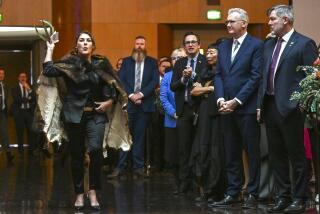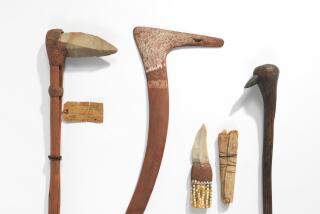Has Life Improved for Aborigines 25 Years After Gaining Right to Vote? : Australia: The countryâs indigenous people have not joined mainstream society--and with a long history of culture clashes, prejudice and genocide--theyâre not sure they want to, either.
PAPUNYA COMMUNITY, Australia â The vitality of Papunya made it the focus of a fledgling Aboriginal art movement 20 years ago. Today the tiny community is a sad symbol of neglect, like the Aborigines who live there.
Twisted playground equipment lies unused and rusting in an overgrown field. No one has cleaned up the glass knocked out of the lone phone booth. Hulks of broken-down cars sit on bare rims. A windmill lies where it collapsed. Garbage litters the wind-blown fields. A few skinny dogs roam the streets in the noon heat.
âOne new teacher came in at night, got her first look around in the daylight, bawled her eyes out and left,â says Alison Anderson, a painter and the communityâs intense spokeswoman.
Only 35 of the 300 residents have jobs; the rest are dependent on government handouts. A handful of shops sit vacant, except for a battered gas station.
Papunya is typical of the Aboriginal communities that dot the unforgiving landscape of Australiaâs Red Center, evidence that the countryâs indigenous people have not joined mainstream society.
With a long history of culture clashes, prejudice and genocide, theyâre not sure they want to, either.
Their problems echo those of North Americaâs Indians: poor health and housing, alcoholism, alienation, high unemployment, short life expectancy, loss of languages and tradition from decades of forced assimilation, domestic violence.
At least 300,000 Aborigines lived across Australia when European colonists arrived in 1788. Over the next 150 years, warfare, massacres and new diseases wiped out three-quarters of them. Today, the number has rebounded to about 300,000--including those of mixed race--less than 2% of the 18 million population.
Most white Australians have little contact with Aborigines, largely because few of the natives live in cities. They make up 22% of the sparsely populated Northern Territory.
Before a referendum on May 27, 1967, granted them citizenship, Aborigines could not vote, were not counted in the census and had no guarantees of wages equal to those of whites. In some states, they could not get married without written consent or swim in the same pools as whites.
âWhat has happened in the 25 years to this day?â the Sydney Morning Herald asked in an editorial marking the voteâs anniversary. âIn many ways, the answer is not much.
âOf course there has been some progress. But compared with white Australians, the general condition of Aborigines--on almost any index--remains not too far off a national scandal.â
The nomadic Aborigines once were viewed as ânoble savages,â with their complex rites and mythology based on closeness with the land and the supernatural beings who created it.
Now Aboriginal art and music are growing in popularity. Scientists increasingly follow Aboriginal advice in ecology. Police use Aboriginal trackers in the Outback.
Aboriginal communities are reclaiming their traditional lands through the courts. But there also is fraud and exploitation, prejudice and misunderstanding.
In frontier-like Alice Springs, at 24,000 people the largest town for at least 745 miles in any direction, there are signs of the longstanding black-white divisions.
Aborigines claim that signs in some stores saying service can be refused for no reason are used to keep them out. The small casino and several restaurants have dress codes.
Nearly a third of Aliceâs 4,000 Aborigines live in 18 permanent town camps, with a combined 170 houses, scattered on the outskirts. Hundreds of others use trees and tarpaulins for shelter in the normally dry bed of the Todd River that runs just a stoneâs throw from the downtown tourist shops.
Dick Kimber, a historian and writer who moved to Alice 23 years ago and has formed strong ties with the Aborigines, says mutual understanding has improved in some areas, but âothers are almost unresolvable. They require very sensitive people on both sides. You canât hope for dramatic conversions.â
For example, Papunya was created in 1960 in the desert foothills of the scenic West MacDonnells range, a 150-mile drive from Alice Springs, half the way on a washboard-rough dirt road.
It was a case of forced assimilation and apartheid. Members of rival tribes lived uneasily side by side in overcrowded one-room brick houses. Schools taught only in English from a European perspective. At night, the white center was off-limits to blacks.
Perhaps cruelest, the government had the power to forcibly take Aboriginal children, mostly those of mixed race, and place them in foster homes to be raised in âwhite ways.â
âWhatever the intentions of people involved in the establishing and running of this settlement may have been, the effect over time has been to give us a feeling of powerlessness over our own lives,â says Anderson, the Papunya spokeswoman.
Anderson is trying to recapture Papunyaâs former energy through a stubborn battle for self-government.
âPoliticians sit in Darwin and Canberra and donât even know what places like Papunya look like,â she says. âAboriginal people need the power to determine what they think is important in life. Itâs really hard when you have to keep fighting with the government for money, proper housing, day-to-day maintenance.â
Last winter, Papunya went without power for four months in a dispute with the government over being forced to start paying for electricity for the first time.
With few jobs and higher prices for food and fuel than in Alice Springs, residents argued that they couldnât afford to pay. So they cooked on open fires that provided warmth at night.
âIt was cold and freezing, but that was the decision we made,â Anderson says. âWe wanted to demonstrate that it wasnât about electricity, it was about power. We had to suffer, but it was worth it. We got national publicity and a lot of support.â
The dispute has bolstered a âpeople powerâ movement and led to formation in July of two groups, One United Voice in central Australia and the Yonglu Government Assn. in far northern Arnhem Land, to represent 30 communities.
There are many problems to be confronted.
About 80% of all criminal offenses by Aborigines in Alice are alcohol-related. Many Aboriginal communities have banned drinking. Empty beer cans and bullet-pocked signs warning of fines and jail terms for violations mark their borders.
Then there are the health problems. Life expectancy is only 56, 20 years below the national average. The infant mortality rate is nearly double the national average. About three-quarters of all Aborigines smoke, double the national rate.
Two recent developments have bolstered the battle for self-recognition.
The specially appointed Royal Commission into Aboriginal Deaths in Custody released an 11-volume report early in January that made 339 recommendations and condemned widespread racism:
âNon-Aboriginal Australia has developed on the racist assumption that it knows best what is good for Aboriginal people. The thrust of this report is that the elimination of disadvantage requires an end of domination and an empowerment of Aboriginal people; that control of their lives, of their communities, must be returned to Aboriginal hands.â
The government responded by announcing a two-phase program with a total of $265 million in extra aid programs.
Aborigines long regarded the concept of terra nullius --that the Australian continent was unoccupied when white settlers arrived--as the epitome of white arrogance. But a landmark High Court decision early last year threw out that justification colonists used to claim the continent as their own.
More to Read
Sign up for Essential California
The most important California stories and recommendations in your inbox every morning.
You may occasionally receive promotional content from the Los Angeles Times.










